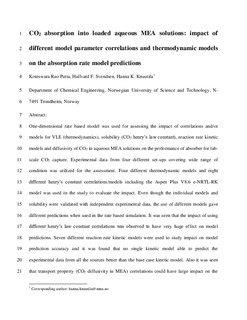CO2 absorption into loaded aqueous MEA solutions: Impact of different model parameter correlations and thermodynamic models on the absorption rate model predictions
Abstract
A two-dimensional discretized rate-based model was used for assessing the impact of correlations and/or models for VLE (thermodynamics), solubility (CO2 henry’s law constant), reaction rate kinetic models and diffusivity of CO2 in aqueous MEA solutions on the absorber model predictions for CO2 capture. Experimental data from four different set-ups covering a wide range of conditions were utilized for the assessment. Four different thermodynamic models and eight different Henry’s constant correlations/models including the Aspen Plus V8.6 e-NRTL-RK model was used in the study. Even though the individual sub-models, e.g. solubility, physical properties, were validated with independent experimental data, the use of a random selection of these models will give different predictions when used in a rate-based simulation. It was seen that using different Henry’s law constant correlations had a huge effect on model predictions. Seven different reaction rate kinetic models were used and it was found that no single kinetic model was able to predict the experimental data from all the sources better than the chosen base case kinetic model. It was also seen that transport property (CO2 diffusivity in MEA) correlations could have a large impact on the outcome of model predictions and correlations based on the N2O analogy were better than the ones based on a modified Stokes-Einstein correlation. As a special case, frequently used kinetic models were used with the thermodynamic model and transport properties taken from Aspen Plus V8.6. It was found that two of the kinetic models predicted the experimental data with acceptable accuracy.
